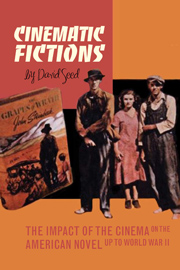Book contents
- Frontmatter
- Contents
- Introduction
- 1 Beginnings
- 2 Modernist Experiments: Gertrude Stein and Others
- 3 H.D. and the Limits of Vision
- 4 Ernest Hemingway: The Observer's Visual Field
- 5 Success and Stardom in F. Scott Fitzgerald
- 6 William Faulkner: Perspective Experiments
- 7 John Dos Passos and the Art of Montage
- 8 Dreiser, Eisenstein and Upton Sinclair
- 9 Documentary of the 1930s
- 10 John Steinbeck: Extensions of Documentary
- 11 Taking Possession of the Images: African American Writers and the Cinema
- 12 Into the Night Life: Henry Miller and Anaïs Nin
- 13 Nathanael West and the Hollywood Novel
- Bibliography
- Index
4 - Ernest Hemingway: The Observer's Visual Field
- Frontmatter
- Contents
- Introduction
- 1 Beginnings
- 2 Modernist Experiments: Gertrude Stein and Others
- 3 H.D. and the Limits of Vision
- 4 Ernest Hemingway: The Observer's Visual Field
- 5 Success and Stardom in F. Scott Fitzgerald
- 6 William Faulkner: Perspective Experiments
- 7 John Dos Passos and the Art of Montage
- 8 Dreiser, Eisenstein and Upton Sinclair
- 9 Documentary of the 1930s
- 10 John Steinbeck: Extensions of Documentary
- 11 Taking Possession of the Images: African American Writers and the Cinema
- 12 Into the Night Life: Henry Miller and Anaïs Nin
- 13 Nathanael West and the Hollywood Novel
- Bibliography
- Index
Summary
Although he does not extend his works in a transcendental direction, the writings of Ernest Hemingway, like those of H.D., emerge from a matrix of modernist experimentation in which the nature of visual perception is explored. Hemingway, however, presents the unusual case of a writer who rarely commented on film and who made a positive point of avoiding Hollywood, only becoming interested in film-making in the 1930s; yet whose work has long attracted commentary on his cinematic method. Probably the earliest instance is that of a French reviewer who declared, on the evidence of A Farewell To Arms (1929), that Hemingway was a ‘man who is at once a camera and a phonograph’. In 1934 Wyndham Lewis, by no means an admirer of Hemingway, quoted a passage from this same novel and reflected: ‘I read this page as I came to it, just as I would watch scenes unfolding on the screen in the cinema’. Bemused by the unusual power of this method, Lewis described Hemingway's writing as a ‘cinema in words’.
Since these early views it has become routine for critics to praise Hemingway's visual immediacy. Here is Harry Levin in 1951 glossing a passage from For Whom the Bell Tolls: ‘each clipped sentence, each prepositional phrase, is like a new frame in a strip of film: indeed the whole passage, like so many others, might have been filmed by the camera and projected on the screen’. In repeating the analogy drawn by Gertrude Stein in the 1930s Levin is compounding the confusion over units within that comparison.
- Type
- Chapter
- Information
- Cinematic FictionsThe Impact of the Cinema on the American Novel up to World War II, pp. 68 - 85Publisher: Liverpool University PressPrint publication year: 2009



